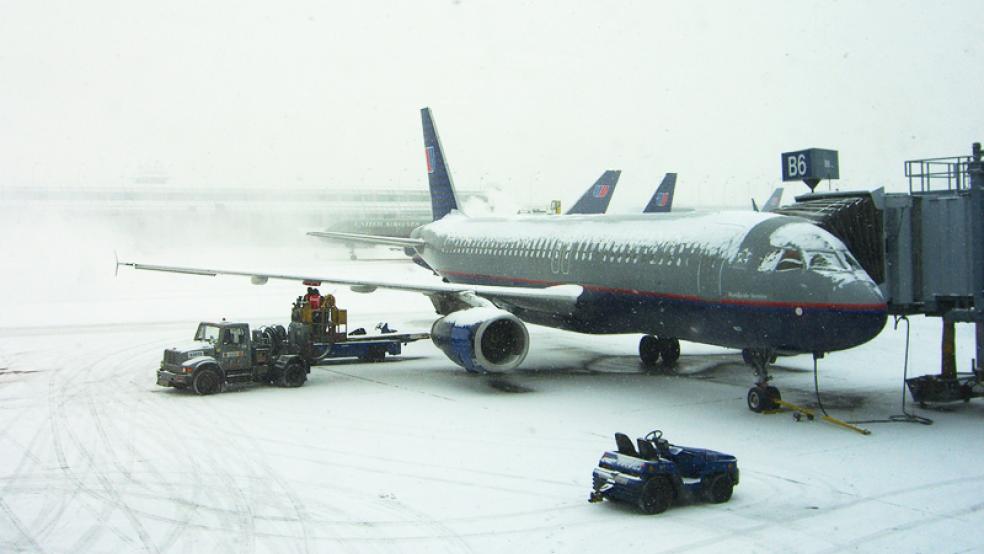The miserable weather and hundreds of airline delays at Thanksgiving capped off a tough year for air travelers. One in five domestic flights this year has arrived behind schedule, the highest since 2008.
If you’re on a tight vacation timeline this winter – say, getting a plane to meet a departing cruise or make it to a one-day family gathering – you’re probably looking at individual airlines’ on-time performance. But picking the right airport will also boost your odds of getting where you’re going on schedule.
A combination of weather and airport traffic largely determines airports’ performance in the cold-weather months. When even a small storm hits the busiest airports, they have little leeway: Takeoffs and landing schedules are packed so tight that if something goes wrong, the effects cascade onto subsequent flights, says Alek Vernitsky of travel site GetGoing.com.
Plus, some airports handle winter weather better than others. Boston’s Logan Airport, for example, has won awards two of the last three years for its efficient snow and ice removal.
Travelers have more choice of hubs than in the past because of airline consolidation, says George Hobica of travel site Airfarewatchdog. In general, smaller warm-weather airports perform better. Travel sites like Kayak.com now offer tools that let you remove delay-prone airports from your itinerary when you’re picking a flight.
Other common-sense guidelines can help you avoid winter delays. Early-morning flights – anything before 11 a.m. – are more likely to get off the ground on time, says Rick Seaney of the air travel planning website FareCompare. Vernitsky suggests flying nonstop in the cold months. You can also check which routes chronically arrive late before you book.
Related: Travel Tip: Airport Food Doesn’t Have to Be Horrible
Beyond those general rules, travelers also can use data to make informed airport choices this season. We crunched the government’s numbers to find the five least-delayed and most-delayed airports in the cold-weather months, calculating average on-time performance during the last three winters for the 29 major airports tracked by the government.
The 5 Best
Sea-Tac, Seattle
- On-time departure average: 85.8%
- Rank: 1st
- Sure, it rains in Seattle – 5 inches a month from December through February. But unlike San Francisco, the city doesn’t get snowstorms or fog, says Hobica. And for a major airport, its traffic is light at 137,000 domestic departures a year, two-thirds fewer than Atlanta International, the country’s busiest airport.
Portland (Oregon) International
- On-time departure average: 85.2%
- Rank: 2nd
- Like Seattle it rains a lot, but when it does, rain in Portland is not accompanied by high winds, says Seaney. The Portland Airport is also small and well-run – at 83,000 domestic departures per year, it handles even less traffic than Sea-Tac.
Charlotte Douglas International
- On-time departure average: 84.8%
- Rank: 3rd (tie)
- Though this is the fifth-busiest airport in the country at 245,000 departures yearly, it still outperforms other major warm-weather airports like those in Houston and Los Angeles. Seaney says its performance is helped by being a key hub for U.S. Airways, which because of its “roots” as a low-cost airline, has a history of turning its planes around quickly. It doesn’t hurt that a lot of its flights go to the Caribbean; winter weather isn’t an issue.
Tampa International
- On-time departure average: 84.8%
- Rank: 3rd (tie)
- Tampa’s airport has the best of all worlds: average winter temperatures of about 65 degrees, little rain, and low traffic (at 75,000 departures a year, it ranks 32nd in the country). It also has a lot of low-cost airlines flying to it, which generally tend to pay more attention to staying on time, Seaney says.
Related: 7 Secrets to Scoring Cheap Airline Tickets
Reagan National (Washington, D.C.)
- On-time departure average: 83.8%
- Rank: 5th (tie)
- Splitting traffic with Dulles International means that the major airport for the nation’s capital has less traffic than you’d expect. It’s only the 18th-busiest airport, at 136,000 departures. And there’s this, says Seaney: “When you’re carrying a senator, you must take off.” Is that true? “Let’s just say that every time a senator gets charged a bag fee, there’s new legislation,” he says.
Salt Lake City International
- On-time departure average: 83.8%
- Rank: 5th (tie)
- This isn’t exactly a warm-weather destination: Average temperatures of about 31 degrees from December through February, and average snowfall amounts higher than those of Denver. But this airport was recognized this year for snow and ice removal, and it’s relatively small, ranking only 21st in the country for domestic departures.
The 5 Worst
JFK International (New York)
- On-time departure average: 78.0%
- Rank: 25th
- One of the world’s busiest airports, JFK is “slot-controlled,” meaning the Federal Aviation Administration strictly limits the number of takeoffs and landings here to manage congestion. That also may mean less flexibility in responding to delays, according to a report last year from the GAO. It also gets an average of 19 inches of snow from December to February.
San Francisco International
- On-time departure average: 77.2%
- Rank: 26th
- One word: fog, says Hobica. There’s also limited runway access, overcrowding, and not enough air traffic control. “You’re much better off flying out of San Jose or Oakland,” says Hobica.
Denver International
- On-time departure average: 75.6%
- Rank: 27th
- If you can avoid the city’s once- or twice-yearly mega-snowstorms, you’ll actually do all right flying to or through Denver, says Seaney. Those events shut everything for 2 or 3 days each time. When they happen, they’re a big deal since this is the 4th-busiest airport in the country.
Newark Liberty International
- On-time departure average: 72.7%
- Rank: 27th
- In addition to being slot-controlled, Newark has many international flights. Those complicate matters, since takeoff and landing schedules are beholden to the caprices of the jet stream coming in and out of Europe, Seaney notes. This airport also is dominated by United Airlines and has few of the low-cost carriers that do better with on-time performance, he says.
Chicago O’Hare International and Chicago Midway International
- On-time departure averages: 72.6% and 70.1%
- Rank: 28th and 29th
- The city’s snowstorms and sometimes 30- to 40-mph winds make camping out in Chicago’s airports almost inevitable. “It’s almost like Groundhog Day,” says Hobica of how predictable it is for passengers to be stranded here by winter storms. He thinks some place other than the Windy City – say, St. Louis – would make more sense as a major hub.
Top Reads at The Fiscal Times:
- Food Fight! Group Says ‘20/20’ Went on Food Scare Binge
- ‘12 Days of Christmas’ Price Tag Leaps by 7.7 Percent
- It’s the Season for Online Charity Scams





